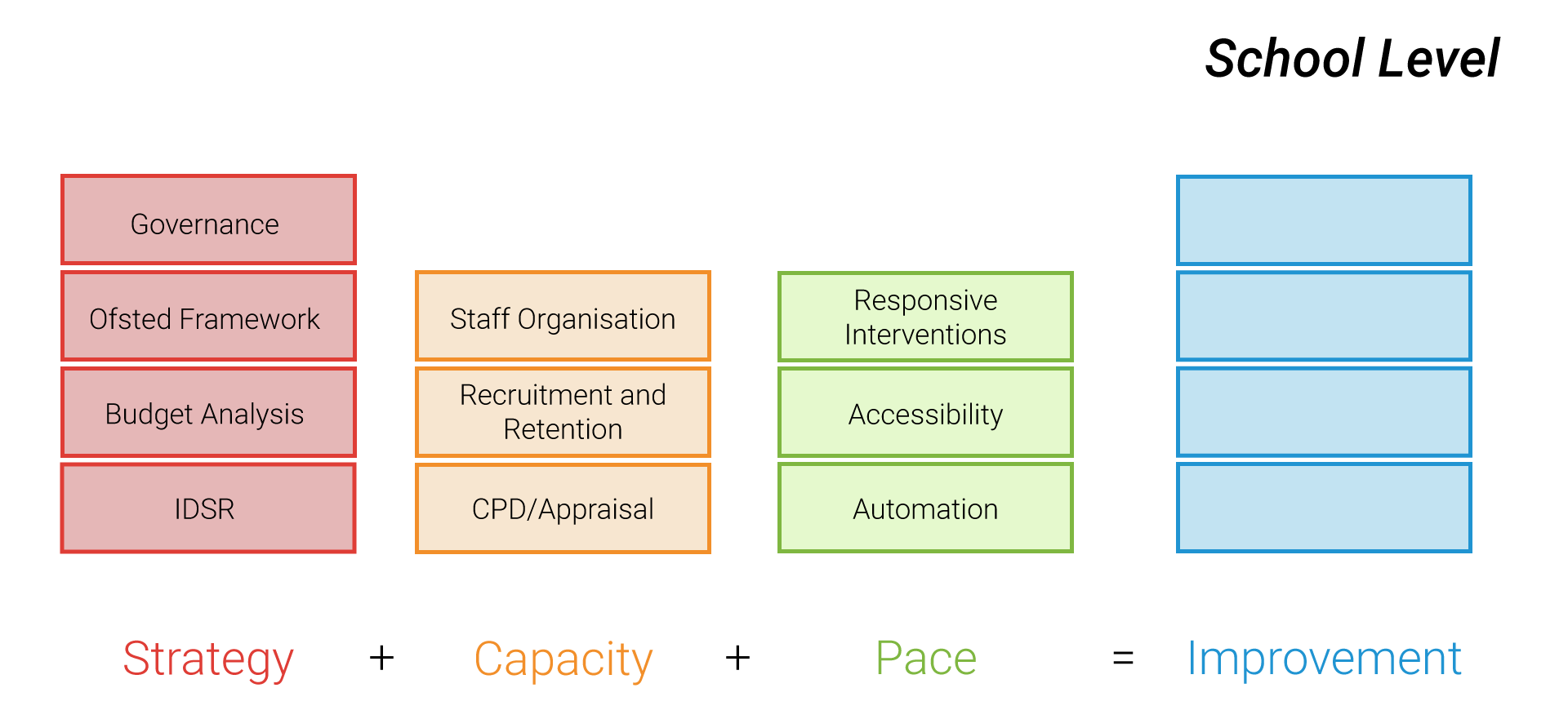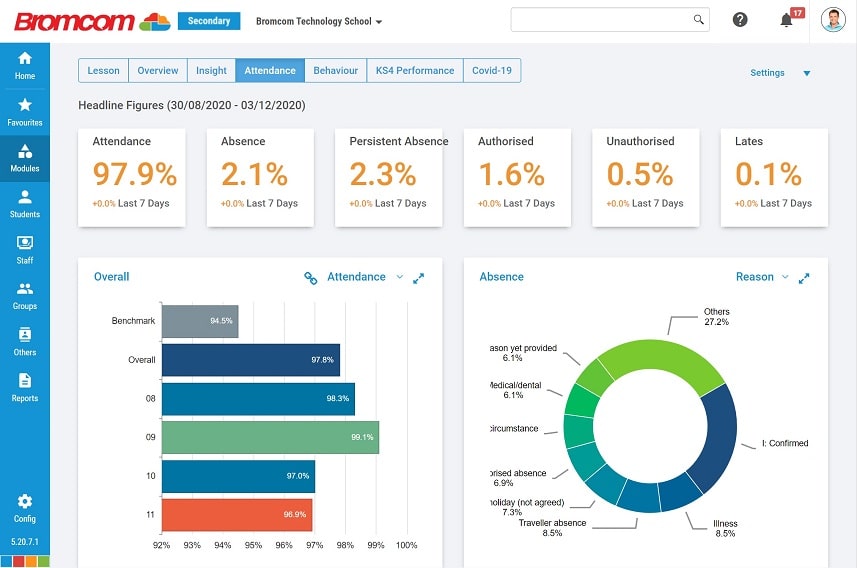In the previous blogs, we reviewed the essential strategy and capacity elements involved in sustainable School Improvement. The combination of a solid plan that has reflective targets alongside a competent workforce continually developing their craft through investment provided by the school, is a great foundation to achieve School Improvement. These two areas are very important in showing the intent behind the project, but setting the pace is key to ensure learners receive the right support at the right time, to gain the right results.

Sir David Carter (2020), Leading Academy Trusts, John Catt
Now let’s consider how the pace of change can make the difference between efficient School Improvement and something more problematic. By creating timescales and seizing the initiative early, schools can ensure that the provision they are providing supports School Improvement. It is important to note that there are two levels of pace needed for the different types of schools in their journey of improvement.

Sir David Carter has stated that ‘Secure Sustainable improvement takes time and leaders need to prioritise and sequence the changes they need to make’. It takes investment to develop a sustainable move forward that will inspire continuous development. Often, this involves a change in culture to create habits and systems that can support the school’s forward momentum. A clear strategy and identification and application of capacity can lead to sustainable changes and long-term achievements for pupils. The larger the change, the more effort and patience is needed to see impact and stability within an organisation that can have a real impact on society.
However, some schools are forced to make changes quickly and show rapid improvement. Rapid School Improvement can be identified when a school has not shown enough progress or teaching and learning standards are not at the required level.
Below is a graph that demonstrates a range of factors that affect the pace of Rapid Improvement. Within this School Improvement series, we have already touched upon the first two areas when identifying how to develop capacity within a school environment.

Tony McAleavy et al (2016), Rapid School Improvement, Education Development Trust
The third factor on the graph identifies that improving data monitoring and processes for tracking pupils’ progress can have a significant effect on developing rapid school improvement. This is something I believe is vital to reflect on the current performance of the pupils and staff within the school. I have identified three key areas that can support teachers to ensure they are using their data monitoring and processes effectively when tracking pupil progress.
Accessibility
To ensure that the correct strategy and capacity has been applied, the user needs access to a wide range of data that provides not only an academic profile of the learner but also a pastoral understanding of the social context they are influenced by. A school leader that can see the whole contextual picture of the child is more likely to provide the best support designed for that individual, as they are aware of all of their circumstances. It is important to view each child holistically, and not just a statistic in a marksheet towards a school goal. Public Health England published work by Duckworth A & Seligman M (2005) stating that “social and emotional competencies have been found to be a more significant determinant of academic attainment than IQ”. So we need to be aware of all of the factors involved to ensure children achieve their potential.
Automation
Schools need to be able to act quickly when it comes to School Improvement. There is no point waiting to make a change as it will have already developed a gap in development. Schools require data and information on performance instantly to make decisions. A school cannot function efficiently if the data they are using is effectively already out of date. Particularly when the time it has taken to collect, process, deduce and analyse has caused a lag in learning time. By working to data deadlines and accessing instant analysis in clear visuals, staff can make quick decisions to ensure no child is left behind or waiting for their own development plan.
Responsive Interventions
When identifying a strategy to support the development of teaching or learning for a student or a staff member, it is important that there are regular reviews of the individual’s performance. This is vital to ensure that there will be a positive outcome to the capacity that has been used. To take this one step further, the intervention that has been put in place also needs to be analysed and scrutinised at every data collection point, so that the leaders who are placing their time and effort into the improvement, can see the development. Automatic reminders, regular data analysis, question level analysis, observations against school standards, are all examples of data that can be collected and instantly analysed to ensure the desired flight path is still on track. Pace can be altered during this discovery. It is important that the data is collected regularly enough to ensure that the support offered is worthwhile and creates a positive impact.
How can Bromcom support the pace of an organisation
Our Cloud-MIS solution offers a variety of features that support the pace setting of school improvement. I think it is important to recognise that the system as a whole is a valuable tool for both sustainable and rapid improvement.
A key area that Bromcom champions is the accessibility of the data within the system. The intuitive interface allows users to find the information they desire with a few clicks. This may seem a small positive or a pedantic point, but as someone with experience of trying to navigate the very depths of a system to find important data, it’s far more productive to use something that provides quick analysis and decision making. Bromcom’s One-Stop Shop approach means that in addition to academic attainment and progress data, there is easy access to the demographic and pastoral information that could influence performance. This holistic profile provides a great platform to understand the reasons why the student has not attained (or exceeded) the levels that were expected of them. Having all data in one place enables staff to make effective decisions and interventions that provide the best support for the student.
The Department for Education has produced a range of guidance that highlights workload issues and aims to reduce ‘unnecessary burdensome practice’. To ensure that our Cloud-MIS supports their users effectively and does not add additional workload, we have created powerful dashboards that can drill right down to individual pupils and records. Bromcom has transformed the way their users interact with data. After all, many people think using pictures, so a graph that highlights a specific issue can quickly draw attention to the right area. The reasoning behind shifting towards a dashboard focus provides a benefit of engagement and comprehension of the data for the user. Dr Lynell Burmak explains that “…unless our words, concepts, ideas are hooked onto an image, they will go in one ear, sail through the brain, and go out the other ear… Images, on the other hand, go directly into long-term memory where they are indelibly etched.” To ensure that school leaders and decision makers see all of the information and act on that knowledge, the data needs to be presented in a way that is easy to engage with. The infographic below demonstrates how our brains are pre-wired to automatically interpret relationships between different images and objects, allowing for almost instant comprehension with minimal energy and effort used.

Velijko Milutinovic et al (2017), Data Flow Supercomputing Essentials, Springer
Bromcom’s dashboards therefore use a hybrid of words and visual stimulus to engage the leader quickly and efficiently, allowing them to comprehend the information quicker too. Robert Horn of the University Center for the Study of Language and Information explained, “When words and visual elements are closely entwined, we create something new and we augment our communal intelligence … visual language has the potential for increasing ‘human bandwidth’—the capacity to take in, comprehend, and more efficiently synthesize large amounts of new information.” In this case, dashboards enable quick decision-making as key patterns and trends are clearly highlighted.

Bromcom Dashboard
Another strength of the Bromcom system is the ability to automate. If data is collected within the system at the right time, the analysis is instant. Reports can be scheduled and sent to the relevant leaders to ensure the correct support can be provided. Automatic alerts can be defined to raise a concern or to remind staff that a target has been reached. This key feature has been provided to a variety of different modules within the system, such as safeguarding, behaviour, attendance, assessment, support and performance management. This reduces the burden of administrative tasks and supports the review process to increase efficiency.
To ensure that productivity is high within the school setting, the diary module enables the planning, managing and reviewing of staff and pupil performance. Regular reminders, scheduled meetings and the ability to integrate with Google and Microsoft, allows the option to virtually participate in meetings too. The Bromcom MIS can act as a strong communication tool with all members of its community, an important part of ensuring that tasks are completed within the time frames set.
Conclusion
Setting the correct pace for an organisation to improve is very important. Bromcom is aware that schools are working at different levels and therefore have different short, medium and long term goals. The MIS solution has been designed to support these different goals by enabling schools to set their own pace. However, all schools need to be responsive to the daily collection of data. Bromcom provides the collation, analysis and presentation of data to school leaders, ensuring that rapid school improvement can happen in any school, anywhere.
